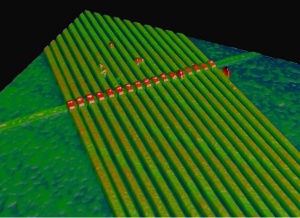HP figures out how memristors work, predicts robot use

Scientists at HP and the University of California, Santa Barbara have discovered the physical and chemical properties of the memristor, a likely component of future memory and computational circuitry.

Scientists have discovered the physical and chemical properties of the memristor, a likely component of future memory and computational circuitry. Photo credit: HP Labs
Using highly-focused X-rays, the researchers gained unprecedented understanding of a device they already knew how to make and use, but without a clear idea of the underlying mechanism. HP hopes memristor-based memory chips will run at least 10 times faster than equivalent flash memory chips, while using a tenth of the power.
In the research, published on Monday in the journal Nanotechnology, the team said that it had new understanding of how current flow caused heating that changed the molecular structure of the device. It also said it had discovered memristors to be very close in functioning to the neurons that pass information around the human brain.
Memristors are simple devices that consist of no more than a thin titanium dioxide film held between two metal electrodes, and they act within circuitry as resistors. However, memristors have the added quality of remembering the resistance they had when current last flowed through them, hence the portmanteau name. Their resistance increases or decreases depending on the direction of the current.
Thermal model
The researchers made their discoveries by non-destructively examining the precise 100nm-wide conductive channel of oxygen-depleted titanium dioxide — actually, Ti4O7 — at the heart of the resistance switching zone, then feeding that image into a thermal model of the memristor.
The material around the channel, ordinary titanium dioxide, changed phase and thus the nature of the inter-molecular gap between it and the conductive channel. That gap sets the overall resistance of the device through quantum tunnelling; the gap's structure was the target of the X-ray investigation.
"One of the biggest hurdles in using these devices is understanding how they work: the microscopic picture for how they undergo such tremendous and reversible change in resistance," said John Paul Strachan of the nanoElectronics Research Group at HP Labs in a statement. "We now have a direct picture for the thermal profile that is highly localised around this channel during electrical operation, and is likely to play a large role in accelerating the physics driving the memristive behaviour."
According to the researchers, memristors mimic biological synapses and could therefore be used to reproduce complex networks of neurons, ultimately helping in the development of semi-autonomous robots.
It is little more than a year since HP Labs announced that memristors could be used not just for memory, but also for performing logic operations. The company first demonstrated memristors in 2008, but they were initially predicted by academic Leon Chua in 1971.
In August 2010, HP said it was preparing to commercialise memristor technology, along with the Korean manufacturer Hynix. At the time, the companies predicted a launch around 2013, saying that memristors would ultimately be able to replace flash, DRAM and even hard drives.